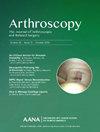The Arthroscopic Subscapular Sling Procedure Results in Low Recurrent Anterior Shoulder Instability at 24 Months of Follow-Up
IF 4.4
1区 医学
Q1 ORTHOPEDICS
Arthroscopy-The Journal of Arthroscopic and Related Surgery
Pub Date : 2024-10-01
DOI:10.1016/j.arthro.2024.02.032
引用次数: 0
Abstract
Purpose
To analyze the results of the subscapular sling procedure developed for anterior shoulder instability in patients with less than 10% anterior glenoid bone loss.
Methods
Patients were treated surgically with the arthroscopic subscapular sling procedure. A semitendinosus graft was used to reconstruct the anterior labrum and to establish a sling suspension around the upper part of the subscapularis tendon. The patients were followed up with radiographs (at 12 and 24 months). Magnetic resonance imaging (MRI) of the shoulder region and clinical examinations were performed at 3, 12, and 24 months. Recurrent dislocation was the primary endpoint. The Western Ontario Shoulder Instability Index (WOSI) and MRI results were secondary outcome measures. An independent physiotherapist assessed residual instability and range of motion.
Results
Fifteen patients were included with a dislocation rate of 0% after 24 months follow-up. There was a significant clinical improvement of the WOSI score from 57% (904) at baseline to 88% (241) at 24 months (P < .001). The proportion of patients with an improvement in the WOSI Total score larger than the estimated minimal clinically important difference was 100% both at 12 and 24 months. MRI showed an intact sling in all patients. External rotation was not significantly reduced (52° at baseline vs 47° at 24 months, P = .211). Flexion and abduction were significantly improved from 152° to 174° (P = .001) and 141° to 170° (P < .001) after 24 months. The surgical procedures were completed without any intraoperative complications.
Conclusions
The subscapular sling procedure resulted in low recurrent shoulder instability and improved patient-reported outcome measures at 24 months of follow-up.
Level of Evidence
Level IV, case series.
关节镜肩胛下吊带术 24 个月随访时肩关节前方失稳复发率低。
目的:本研究的目的是分析肩胛下吊带术的效果,该手术是针对肩关节前侧不稳定而开发的,适用于盂前骨质缺损少于10%的患者。目的是探讨该手术能否成功预防肩关节复发性脱位:患者采用关节镜下肩胛下吊带术进行手术治疗。使用半腱肌移植物重建前唇,并在肩胛下肌腱上部建立吊带悬吊。对患者进行了 X 光随访(12 个月和 24 个月)。3个月、12个月和24个月时进行肩部磁共振成像(MRI)和临床检查。复发性脱位是主要终点。西安大略省肩关节不稳定指数(WOSI)和核磁共振成像结果是次要结果测量指标。一位独立理疗师对残余不稳定性和ROM进行了评估:随访24个月后,15名患者脱位率为0%。WOSI评分有了明显的临床改善,从基线时的57%(904人)提高到24个月时的88%(241人)(p < 0.001)。12个月和24个月时,WOSI总分改善幅度大于最小临床意义差异(MCID)估计值的患者比例均为100%。磁共振成像显示,所有患者的吊带都完好无损。外旋没有明显减少(基线为52°,24个月时为47°,P = 0.211)。屈伸和外展则有明显改善,分别从152°增至174°(P=0.001)和141°增至170°(P=0.001):肩胛下吊带术后复发的肩关节不稳定性较低,24个月随访时患者报告的结果也有所改善。
本文章由计算机程序翻译,如有差异,请以英文原文为准。
求助全文
约1分钟内获得全文
求助全文
来源期刊
CiteScore
9.30
自引率
17.00%
发文量
555
审稿时长
58 days
期刊介绍:
Nowhere is minimally invasive surgery explained better than in Arthroscopy, the leading peer-reviewed journal in the field. Every issue enables you to put into perspective the usefulness of the various emerging arthroscopic techniques. The advantages and disadvantages of these methods -- along with their applications in various situations -- are discussed in relation to their efficiency, efficacy and cost benefit. As a special incentive, paid subscribers also receive access to the journal expanded website.

 求助内容:
求助内容: 应助结果提醒方式:
应助结果提醒方式:


